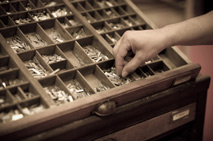
Composition
Setting Type
The first thing you need to think about is the measure you'll be working to. This is the maximum length of the line, so it will be narrower than the paper/card you're going to print on. Don't forget that it will have to fit into a chase, too.
The unit of measure to use is the Em. Although Ems can be relative to the size of the type, the default size is 12pt and that's the sort of Ems we're talking about here.
Whatever measure you choose (it's normal practice to use an even number), you'll need leads the same length. If you have a limited range of leads and no lead-and-rule cutter, you'll have to take this into consideration!
Adjust your composing stick either exactly to this measure, or 1pt wider.
It's your leads that are the deciding factor here; are they cut to dead measure, or do they have ‘squeeze allowance’?
Many leads in the trade were cut exactly to the measure. If that's what you've got, set your composing stick that 1pt wider, so you can slot a lead in (and slide it out again) without resorting to a mallet!
The leads we use here at the Happy Dragons’ Press, and the ones we sell in our Composing Room Stores, have ‘squeeze allowance’. This means they're cut 1pt shorter than the nominal length, and you can set your composing stick to the measure exactly.
The way to get this dead right is to line up a row of 12pt Em spaces in your composing stick and set it to fit; twenty 12pt Em spaces make a 20 Em measure.
There isn't any magic in composing type, at least not until you get to the justification stage when you get near to the end of the line. If you're right handed, hold the stick in your left hand. Hence forth we'll assume the stick will be in your right hand, with apologies to all those lefties out there.
Here's how to hold your comp stick:
[illustration]Notice how the thumb and forefinger are poised ready to control the (relatively loose) line which you're setting.
You'll need to tip the stick so the top leans back slightly, otherwise the type will fall out. You'll probably find this instinctive!
So lets get started. Slide a lead in to the bottom (if you have a ‘setting rule’ of the right measure, you can use that here instead of a lead).
- Select your first sort (piece of type) from the type case.
- Turn the sort upside down and push it up against the adjustable (left) side of the composing stick (so the nick shows).
- The next sort goes to the right of this, and so on. For temporary spacing between words, use a Thick.
- When you near the end of the line, you'll need to justify it. For ragged right (or the end of a paragraph) this is as simple as filling the gap at the end of the line with spacing.
- Place another lead on top of the finished line, and start the next line one on top. A very useful tip for beginners is to use two leads between lines. Then, if you realise you've messed something up (eg left out a word) when you come to take a proof, you can safely whip the whole line out, sandwiched between the leads.
- If you're setting more text than will comfortably fit in the composing stick, transfer it to a galley – very carefully indeed, moving only one line at a time – and start setting the next few lines in the now empty stick.
- Finished setting all the text? Then it's time for imposition.
You Might Also Like...
